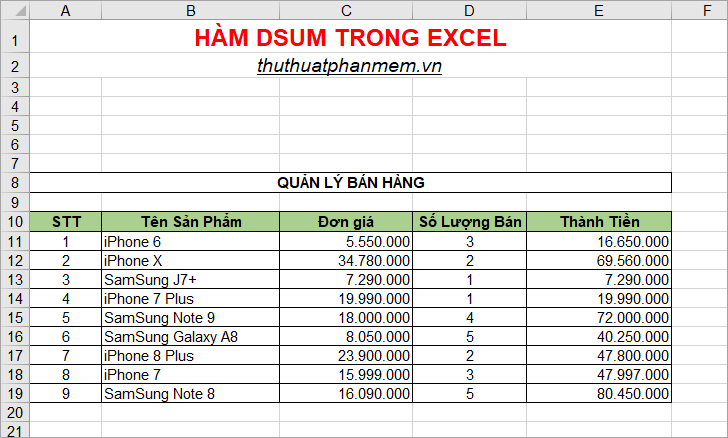DSUM function in Excel, how to use DSUM function and examples
The DSUM function in Excel is a fairly common function with a fairly simple usage. But if you do not know how to use the DSUM function, you can refer to the following article to better understand the DSUM function and examples of how to use the DSUM function in Excel.

The following article will share to you the description, syntax and usage examples of DSUM, please follow along.
Describe the DSUM function
The DSUM function is a function that adds numbers in a field (column) in a data list that satisfy the conditions you specify.
Syntax of the DSUM function
= DSUM (database; field; criteria)
Inside:
- Database is a required argument, this is the list (database) made up of a cell range. This data list is a list of data that is records and columns of data are fields, containing fields for checking conditions and fields for summing. The list contains the first row as column headings.
- Field is a required argument, which specifies the column name used to sum the data. You can enter the column header name in quotes or a number representing the position of the column in the list without quotes (for example, number 1 is the first column, number 2 is the second column . in database ) or a reference to the column heading you want to sum.
- Criteria is a required argument, this is the range of cells containing the conditions that you want the DSUM function to check.
Notice the range of criteria conditions
- You can use any range for the criteria argument if the range contains at least one column label and at least one cell below the column header that determines the condition for that column.
- Don't put the range of conditions at the bottom of the list, because there won't be a place to add other information to the list.
DSUM function example
Suppose you have the following data table:

First, you can create a conditional range for the DSUM function, because you need to count the iPhone products that have a lot of iPhone lines, the condition you enter the wildcard is the * after the iPhone.

Next, you enter the DSUM function formula as follows:
= DSUM (A9: E18; "Thanh Tien"; C4: C5)
Inside:
- A9: E18 is the database range here that contains the column to be calculated and the column that contains the conditions to check.
- 'Pay Money' is the column heading where you will use the values in that column to calculate the total.
- C4: C5 is a range of conditions containing column headings and a condition value.

Or you can change the value in Field to refer to the column heading Thanh Tien as follows: = DSUM (A9: E18; E9; C4: C5) your results are the same as above.

2. Calculate the total amount sold for products with a Quantity greater than 3. You first create a conditional range with the heading Sales Quantity column , and the condition value is> = 3.

Next you enter the formula DSUM function:
= DSUM (A9: E18; E9; C4: C5)
Inside:
- A9: E18 is the range of databases you will work on.
- E9 is the reference to the column header to be summed.
- C4: C5 is the criteria condition range with the Sales Quantity column heading and the condition is> = 3.

Above the article has shared to you the description, syntax, specific examples of the DSUM function in Excel. You can use the DSUM function to process data as needed. Good luck!
You should read it
- OR function in Excel, how to use the OR function, and examples
- DCount function in Excel - How to use the DCount function and examples using the DCount function
- INDIRECT function in Excel - How to use INDIRECT function and examples using INDIRECT function
- VLOOKUP function to use and specific examples
- Offset function in Excel - Usage and examples
- IRR function in Excel - Usage and examples
- The MID function in Excel, how to use the MID function, and examples
- Function Address - The function returns the address of a cell in Excel (usage, examples, examples)
May be interested
- Excel date function - Usage and examples
 the date counting function in excel is one of the most effective functions of this software. because excel usually works in the field of statistics and calculations, it is extremely necessary to record dates. to help you understand this function, let's come to the following article of tipsmake.
the date counting function in excel is one of the most effective functions of this software. because excel usually works in the field of statistics and calculations, it is extremely necessary to record dates. to help you understand this function, let's come to the following article of tipsmake. - The MID function in Excel, how to use the MID function, and examples
 the mid function in excel, how to use the mid function, and examples. the mid function in excel is a function of the text function group, you use the mid function if you want to cut the string in the middle of the text string when processing the string. if you do not know or do not understand the mid function, then you
the mid function in excel, how to use the mid function, and examples. the mid function in excel is a function of the text function group, you use the mid function if you want to cut the string in the middle of the text string when processing the string. if you do not know or do not understand the mid function, then you - PMT function in Excel - Usage and examples
 the pmt function is one of the built-in financial functions of the excel software used to calculate the payment for a loan based on regular payments and a constant interest rate. the pmt function is not only useful for businesses, but also very practical for users if you want to calculate a loan.
the pmt function is one of the built-in financial functions of the excel software used to calculate the payment for a loan based on regular payments and a constant interest rate. the pmt function is not only useful for businesses, but also very practical for users if you want to calculate a loan. - GAMMAINV function in Excel, how to use and examples
 the gammainv function in excel helps calculate the inverse value of the cumulative gamma distribution, which is used in statistics and data analysis. this article will guide you on how to use the gammainv function with specific illustrative examples.
the gammainv function in excel helps calculate the inverse value of the cumulative gamma distribution, which is used in statistics and data analysis. this article will guide you on how to use the gammainv function with specific illustrative examples. - How to use the MAXA function in Excel, detailed examples
 the maxa function in excel helps find the largest value in a data set, including numbers, logical values, and text containing numbers. this is different from the max function, which only counts numbers. let's learn the syntax and usage of the maxa function with practical examples.
the maxa function in excel helps find the largest value in a data set, including numbers, logical values, and text containing numbers. this is different from the max function, which only counts numbers. let's learn the syntax and usage of the maxa function with practical examples. - LEFT function in Excel, how to use LEFT function and illustrative examples
 left function in excel, how to use left function and illustrative examples. left function in excel is a function of string processing function, you use left function when you need to cut the character string to the left of the text string. if you need to learn more about mid functions, be patient
left function in excel, how to use left function and illustrative examples. left function in excel is a function of string processing function, you use left function when you need to cut the character string to the left of the text string. if you need to learn more about mid functions, be patient - How to use the SUMIF function in Excel
 the sumif function in excel is a function used to compute values in a specified range. the sumif function can be used for summing cells based on the date, data and text that are connected to the specified area.
the sumif function in excel is a function used to compute values in a specified range. the sumif function can be used for summing cells based on the date, data and text that are connected to the specified area. - Choose function in Excel, how to use the Choose function and illustrative examples
 choose function in excel, how to use the choose function and illustrative examples. you are looking for ways to use the choose function in excel so you can use the choose function quickly. so, please refer to the following article to know the choose function syntax, for example how
choose function in excel, how to use the choose function and illustrative examples. you are looking for ways to use the choose function in excel so you can use the choose function quickly. so, please refer to the following article to know the choose function syntax, for example how - DCOUNT function in Excel - Usage and practical examples
 the dcounta function is one of many frequently used math functions in excel. the dcount function helps you count non-blank data cells in list columns or data arrays with defined conditions.
the dcounta function is one of many frequently used math functions in excel. the dcount function helps you count non-blank data cells in list columns or data arrays with defined conditions. - The function takes whole parts in Excel - Specific examples
 the function takes whole parts in excel - specific examples. excel has 2 functions that involve taking integer parts: quotient, int. there are many people who have a confusion between these two functions, only when you understand the nature of each one can you use them most accurately.
the function takes whole parts in excel - specific examples. excel has 2 functions that involve taking integer parts: quotient, int. there are many people who have a confusion between these two functions, only when you understand the nature of each one can you use them most accurately.










 DCount function in Excel - How to use the DCount function and examples using the DCount function
DCount function in Excel - How to use the DCount function and examples using the DCount function Functions rounded up, how to round up in Excel
Functions rounded up, how to round up in Excel INDIRECT function in Excel - How to use INDIRECT function and examples using INDIRECT function
INDIRECT function in Excel - How to use INDIRECT function and examples using INDIRECT function Random function in Excel (RAND function), how to use the Random function and examples
Random function in Excel (RAND function), how to use the Random function and examples